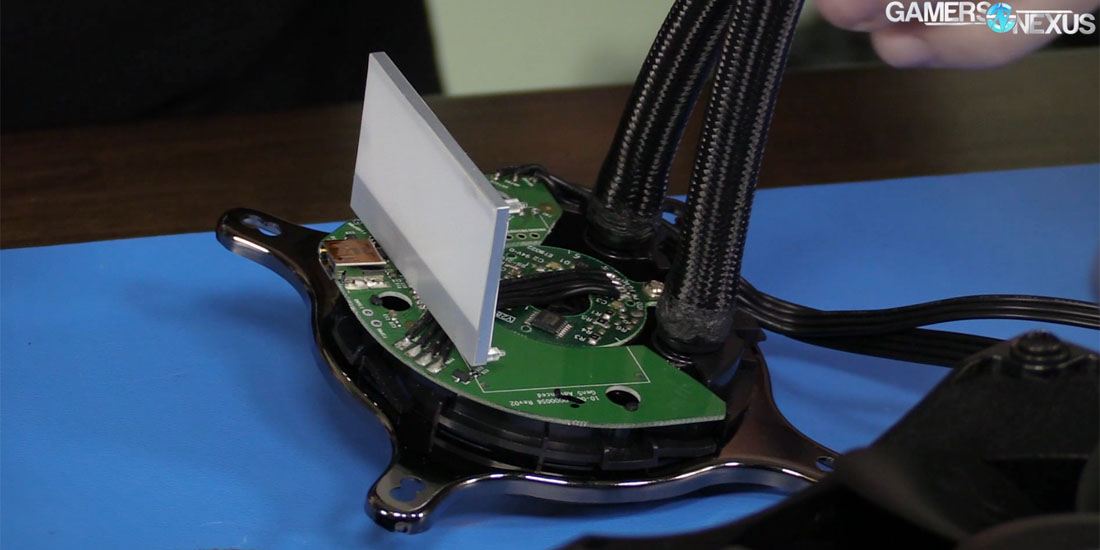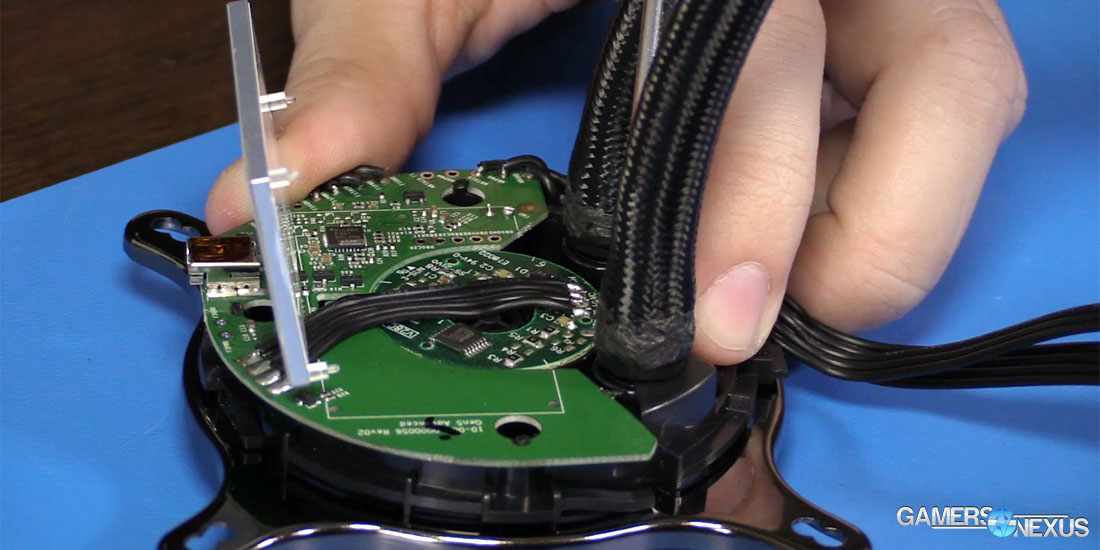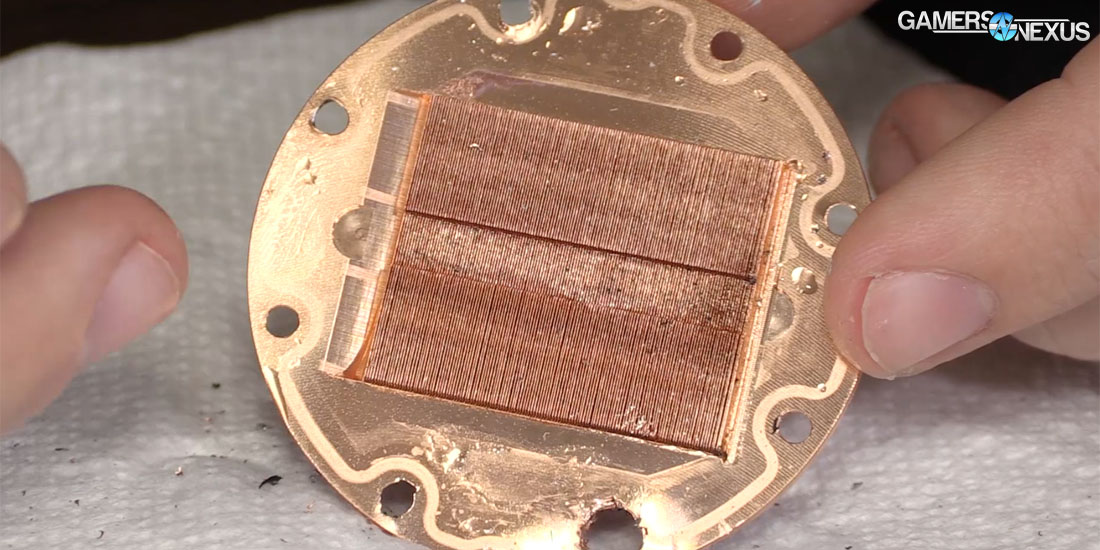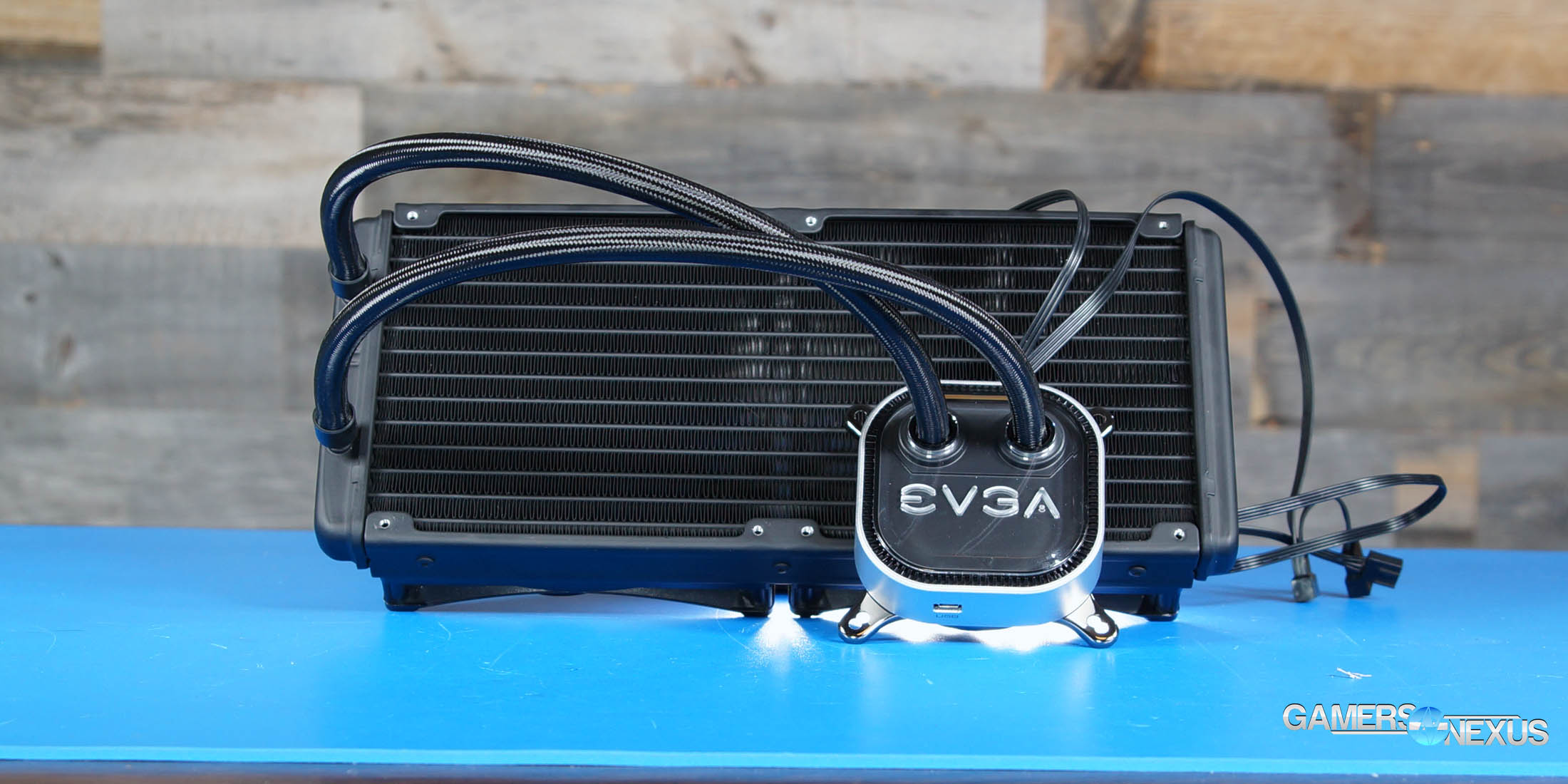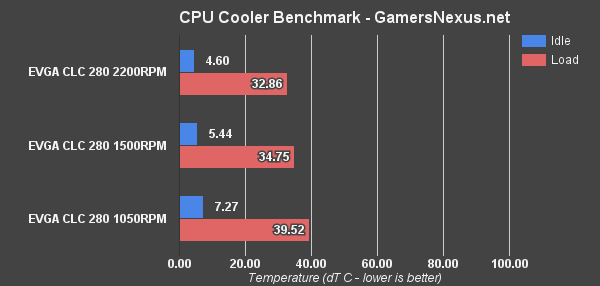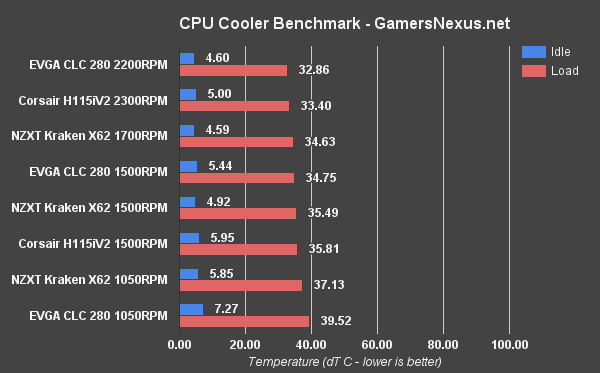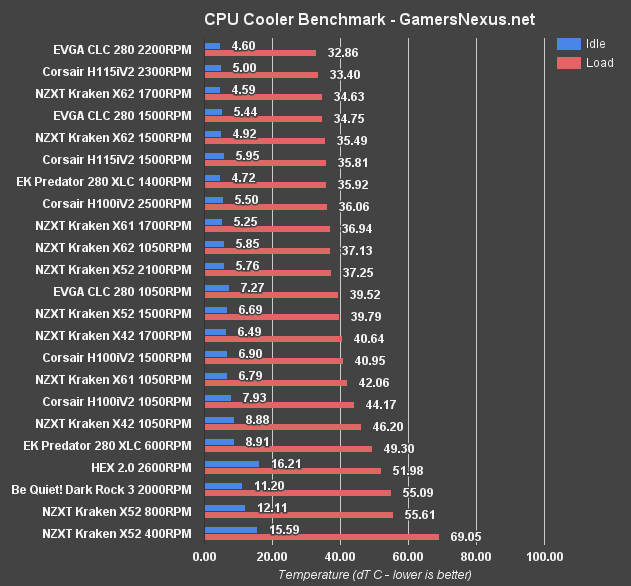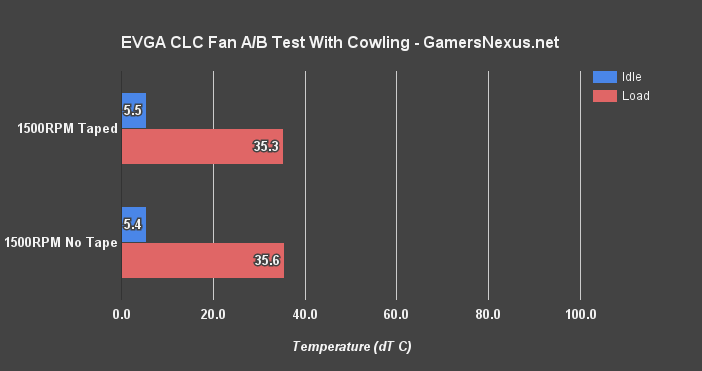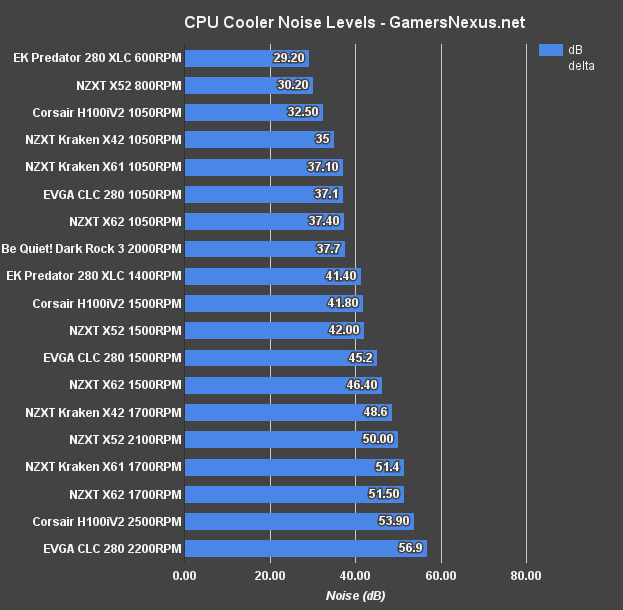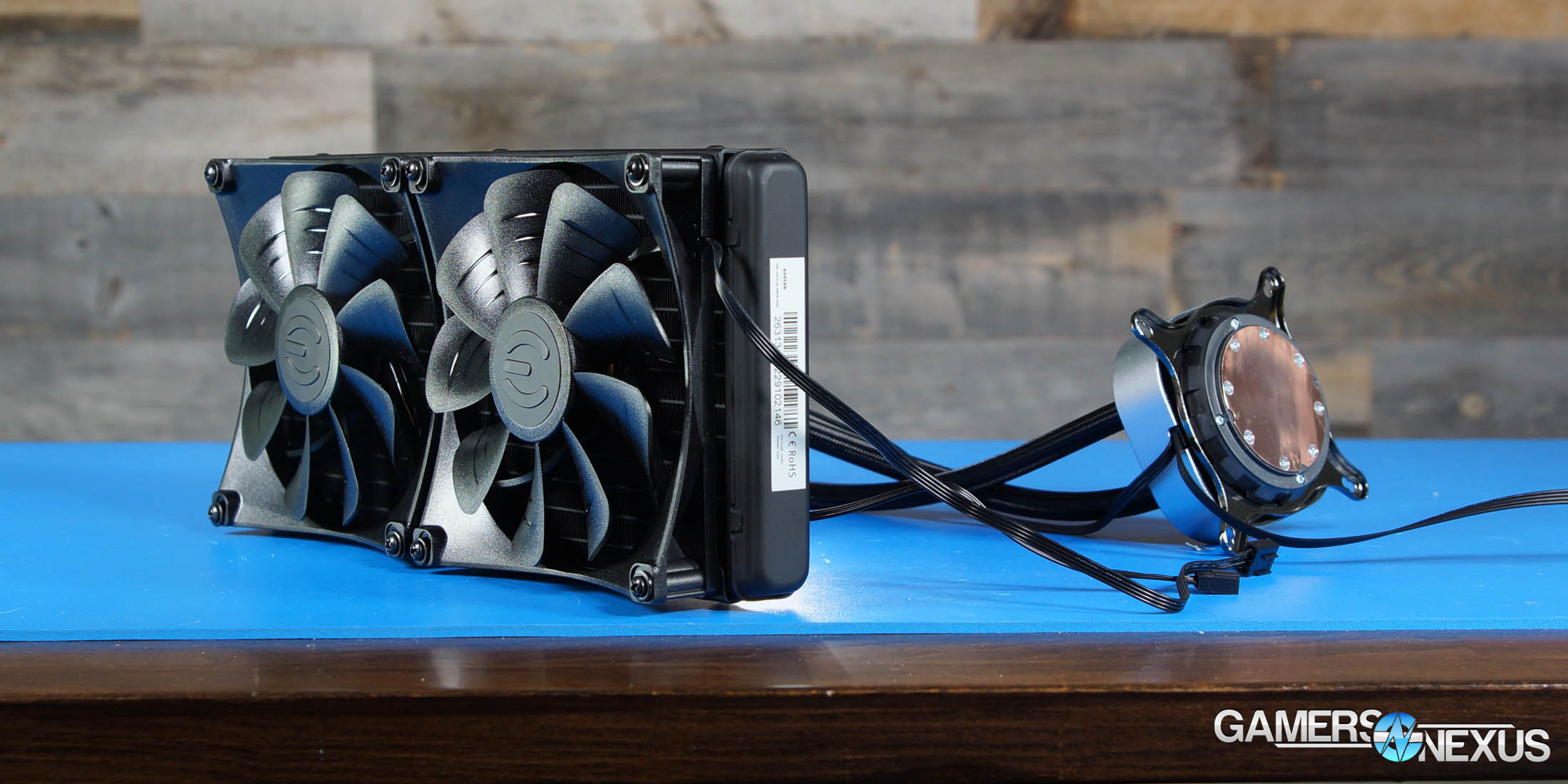EVGA’s closed-loop liquid cooler, named “Closed-Loop Liquid Cooler,” will begin shipping this month in 280mm and 120mm variants. We’ve fully benchmarked the new EVGA CLC 280mm versus NZXT’s Kraken X62 & Corsair’s H115iV2 280mm coolers, including temperature and noise testing. The EVGA CLC 280, like both of these primary competitors, is built atop Asetek’s Gen5 pump technology and primarily differentiates itself in the usual ways: Fan design and pump plate/LED design. We first discussed the new EVGA CLCs at CES last month (where we also detailed the new ICX coolers), including some early criticism of the software’s functionality, but EVGA made several improvements prior to our receipt of the review product.
The EVGA CLC 280 enters the market at $130 MSRP, partnered with the EVGA CLC 120 at $90 MSRP. For frame of reference, the competing-sized NZXT Kraken X62 is priced at ~$160, with the Corsair H115i priced at ~$120. Note that we also have A/B cowling tests toward the bottom for performance analysis of the unique fan design.
Relatedly, we would strongly recommend reading our Kraken X42, X52, & X62 review for further background on the competition.
EVGA CLC 280mm Tear-Down
We’ve got a full tear-down video going live tomorrow, but some photos from the process are embedded below. The EVGA CLC 280mm cooler uses the expected Gen5 Asetek pump with minimal internal customizations, beyond the usual LED plate and diffuser. Internally, the pump block consists of the impeller, the coldplate and its densely packed microfins, and a foam noise damper between the top of the pump block and the pump plate.
Two PCBs exist internally and are oriented in an outer/inner layout. The outer PCB is for the LED management and controller, the inner PCB is for pump control and is provided by Asetek. This is similar to the Corsair H1XXi series PCBs, but significantly different from the NZXT X42/X52/X62 series. You can view our NZXT tear-down here for a comparison.
EVGA’s cooler comes with the usual Intel and AMD brackets, and will offer free AM4 brackets for those who purchase a unit prior to the Ryzen launch. Nothing is new with regard to mounting – it’s using the same trivial-to-install Asetek cap screws and standoffs as always, which we’ve come to appreciate for their simplicity and strength.
A mini USB cable runs to a USB2.0 header on the board to provide RGB LED control via software. The software wasn’t ready for us to fully dig through prior to this review’s publication, but we’ve worked with the basics and can go through a few features that are noteworthy: EVGA plans to offer user-upgradeable firmware are major, we think, as is their intent to synchronize GPU and cooler LEDs through the software. It’d be interesting if EVGA also explored this for their motherboards.
At CES, we criticized EVGA’s initial plans to rely on liquid temperature for the fan speed adjustment, as we’ve proven that liquid temperature is hugely disparate from actual core temperature. This is particularly true with Kaby Lake, where it is neither unreasonable nor uncommon to see a ~29-33C liquid temperature while pumping a 95C package temperature. For this reason, building fan speed based upon liquid temperature is inadvisable, but EVGA was responsive to criticism and (as we understand it) has updated the software to function with greater sense.
The software offers usual fan speed control options and relies on an internal thermocouple for liquid temperatures, which we show in our tear-down video that goes live tomorrow. As expected, the cooler is an assemblage of plastic and a coldplate comprising the pump housing, with densely packed copper microfins for increased surface area.
Color tuning and profiles are more limited than what you’ll find with NZXT, but also more advanced than what Corsair offers on the H115iV2. EVGA strikes a mix and lands dead center in terms of price-to-customization, with regard to visuals.
Continue to Page 2 for CPU cooler testing methodology.
CPU Cooler Testing Methodology
CPU cooler testing is conducted using the bench defined below. We use a bench that is more carefully crafted for noise performance, opting for a passively cooled PSU and 23% RPM 980 Ti blower fan for very low system noise.
We strongly believe that our thermal testing methodology is among the best on this side of the tech-media industry. We've validated our testing methodology with thermal chambers and have proven near-perfect accuracy of results.
Conducting thermal tests requires careful measurement of temperatures in the surrounding environment. We control for ambient by constantly measuring temperatures with K-Type thermocouples and infrared readers. Two K-Type thermocouples are deployed around the test bench: One (T1) above the bench, out of airflow channels, and one (T2) approximately 2-3" in front of the cooler's intake fan. These two data points are averaged in a spreadsheet, creating a T3 value that is subtracted second-to-second from our AIDA64 logging of the CPU cores.
All six CPU cores are totaled and averaged second-to-second. The delta value is created by subtracting corresponding ambient readings (T3) from the average CPU core temperature. We then produce charts using a Delta T(emperature) over Ambient value. AIDA64 is used for logging thermals of silicon components, including the CPU and GPU diodes. We additionally log core utilization and frequencies to ensure all components are firing as expected. Voltage levels are measured in addition to fan speeds, frequencies, and thermals.
The cores are kept locked to 3.8GHz (x38 multiplier). VCore voltage is locked to 1.141v for the CPU. C-States are disabled, as is all other power saving. The frequency is locked without any interference from boost or throttle functions. This is to ensure that the CPU does not undergo any unexpected/uncontrollable power saving or boost states during testing, and ensures that the test platform remains identical from one device to the next.
Fan speeds are manually controlled unless otherwise defined. For liquid coolers, pumps are set to 100% speed unless otherwise defined.
No open bench fans are used for these CPU cooler tests. Only fans which are provided with the cooler are used.
| GN Test Bench 2015 | Name | Courtesy Of | Cost |
| Video Card | GTX 980 Ti Reference 23% RPM | NVIDIA | EOL |
| CPU | Intel i7-5930K CPU @ 3.8GHz | iBUYPOWER | $580 |
| Memory | Corsair Vengeance 32GB 2666MHz | Corsair | $175 |
| Motherboard | EVGA X99 Classified | GamersNexus | $365 |
| Power Supply | Enermax DigiFANLESS | Enermax | $250 |
| SSD | HyperX Savage SSD | Kingston Tech. | $130 |
| Case | Top Deck Tech Station | GamersNexus | $250 |
| CPU Cooler | This is what we're testing! | - | - |
We use an AMPROBE multi-diode thermocouple reader to log ambient actively. This ambient measurement is used to monitor fluctuations and is subtracted from absolute GPU diode readings to produce a delta value. For these tests, we configured the thermocouple reader's logging interval to 1s, matching the logging interval of GPU-Z and AIDA64. Data is calculated using a custom, in-house spreadsheet and software solution.
Our test starts with a 180s idle period to gauge non-gaming performance. A script automatically triggers the beginning of a CPU-intensive benchmark running Prime95 LFFTs. Because we use an in-house script, we are able to perfectly execute and align our tests between passes.
Continue to Page 3 for EVGA CLC temperature results.
Starting with EVGA Only
Let’s start with only the EVGA results, then we’ll include other 280mm coolers. This will help simplify data presentation so that there is a cumulative increase in DUTs on the chart, since it otherwise gets complicated quickly.
Averaged across more than 1000 cells of data, we’re seeing a load temperature of 39.5C delta T while at the lowest fan RPM with the EVGA CLC 280, matched with a 7.3C idle temperature. The 1500RPM temperatures land at 5.4C idle and 34.7C load delta T, with the unbearably loud 2200RPM fan speed getting us an extra 2 degrees Celsius reduction in load temperatures. It’s absolutely not worth the noise though, as this output resembles a server room. We’ll look at dBA numbers last for folks curious about noise output.
EVGA CLC 280mm vs. Kraken X62 & Corsair H115i
Let’s add the Kraken X62 and Corsair H115iV2 numbers to this chart.
Matching first against NZXT’s Kraken X62, the EVGA 280mm CLC, when matching RPMs to 1500, performs approximately 0.75C better than NZXT’s Kraken X62. For the most part, this is a shallow victory. We’ve got a known variance of approximately 0.5C in our results after accounting for calibration anyway, so these two coolers are more or less identical. NZXT is running at 35.49C delta T, with EVGA operating at 34.75C delta T.
At the top-end, EVGA has more RPM headroom on its fans to support a higher speed, and therefore tops the charts at 32.86C delta T – pretty damn good, but again, very loud. NZXT’s highest RPM is 1700, landing it at 34.63C delta T.
Moving down to 1050RPM, we see EVGA start to lose some ground against NZXT’s X62 unit. Our hypothesis to this 2C deficit against NZXT’s cooler is that EVGA likely loses power toward the low-end of the PQ curve, which is strictly a function of the unique fan design.
Let’s talk Corsair now.
Corsair’s competing H115i is priced at $120, making it $10 cheaper than EVGA’s cooler and $40 cheaper than NZXT’s cooler. Looking at the performance, we see Corsair’s H115i at 1500RPM is functionally identical to the Kraken X62, and falls within our test-to-test variance. The Corsair and NZXT units are equal strictly in terms of cooling at this RPM, making Corsair the obvious choice if you don’t care for the LEDs. EVGA’s CLC 280mm cooler outperforms Corsair by about 1C when at 1500RPM. When we look at max RPMs, Corsair’s cooler can hit 2300RPM with its SP series fans, landing it at 33.4C load. EVGA’s new CLC 280 cooler lands at 32.86C load.
EVGA CLC 280 Results vs. EK Predator, Kraken Series, Corsair H100iV2
And finally, here’s a chart with the full results. This has a couple other coolers present, if you’re curious, though the most directly comparable units are still the 280mm coolers. Included above, we have also tested the smaller Kraken X52 240mm cooler, Corsair H100iV2 240mm cooler, and last-gen variants.
EVGA CLC 280 Fan Cowling Depth Ad-Hoc A/B Benchmark
We decided to test the fan cowling depth (squared casing) on the new EVGA CLC 280 fans, seeing as they're so uniquely shaped and begged questions related to air "leakage" out the sides of the casing. Note the above "no tape" test was re-done as it had new thermal compound applied following the first round of tests, so was done again. For this test, we taped off the sides of the fans for an ad-hoc/rapid prototype of the fan with some cowling; this is not necessarily identical to how plastic would function, but as it was taut and formed the barrier, we still have a good baseline understanding. The results show that the fan cowling difference -- although visually significant -- does not present any noteworthy performance gap between the squared fan casing vs. EVGA fan casing designs. With a 0.3C swing, we are within our 0.5C test variance and can call these functionally equivalent. Despite EVGA's fans feeling like they are leaking air out the sides, they are performing just the same as if they had the squared casing. There may be a noise benefit, but we will have to test further later.
EVGA CLC 280 Noise Testing
This is our final chart. For noise levels measured at 20” with a dB meter, we’re seeing the EVGA 280 and NZXT 280mm coolers both landing around 37dBA with a 1050RPM, though keep in mind that EVGA was 2C warmer at this speed, so there’s a bit of a trade-off. At 1500RPM, where EVGA was about 0.75C cooler thanks to its PQ curve, the EVGA unit runs at 45.2dBA with the NZXT X62 at 46.4dBA. We still have to test the Corsair H115i for noise levels, and will do that once back from our current trip.
Conclusion: EVGA CLC 280 vs. NZXT X62 & Corsair H115iV2
EVGA’s first attempt at an AIO is remarkably strong; they’ve come out swinging with the CLC series, outranking NZXT in noise levels just barely, and performing with a slight advantage in some cooling tests. EVGA falls behind by 2C when at the lower end of the fan speed curve, and could likely improve that by optimizing the fan design / static pressure for future generations. For a first generation product, EVGA has done well to rely on expert input from its partners at Asetek and its media / channel partners during development. It is not common that we see a first attempt at entering a new industry go over competitively (outside of price, anyway).
Ultimately, the product stack now looks like this: If you only care about price, the H115i is a strong competitor and significantly cheaper ($120) than NZXT’s X62 ($160). NZXT is the winner in the RGB department by a long shot, but also asks $160 for the unit. EVGA strikes a balance between price and looks, but still manages to pull ahead in cooling performance at roughly the same decibel output as NZXT’s X62. EVGA’s CLC 280mm cooler is priced actually reasonably for a debut launch, for once, and sits at $130 between the neighboring competition.
If function is all that matters, Corsair does have the most compelling price-to-performance argument in both the 240mm and 280mm categories. If you’re not hardcore about NZXT’s visual focus but still seek something more LED-driven than Corsair’s H115i, the EVGA CLC makes sense.
